Exhibition | Maria Cosway (1760–1838)
Opening this month at the Pasquale Paoli Museum in Merusaglia:
Maria Cosway (1760–1838): A strada eccezziunale di un’artista
Museu Pasquale Paoli, Merusaglia (Corsica), 18 May — 30 October 2024
Curated by Amandine Rabier
 Maria Cosway (1760–1838): A Strada eccezziunale di un’artista (L’itinéraire singulier d’une artiste), présentée au Musée Maison natale de Pasquale Paoli raconte le cheminement d’une femme brillante que tout prédestinait à une grande carrière d’artiste dans la High Society anglaise et qui, contre toute attente, trouvera sa véritable émancipation en renonçant à sa première vocation pour se consacrer à l’éducation des jeunes filles. Ami fidèle, Pasquale Paoli (1725–1807) fut présent à chaque étape de cette vie singulière. Ses lettres à l’attention de Maria Cosway, tel un fil rouge, ponctuent les différentes sections de cette exposition. Fruit de deux années de travail en collaboration avec des institutions britanniques et italiennes reconnues, l’exposition s’accompagne d’un catalogue édité en français et en anglais, richement illustré et documenté par des historiens d’art réputés, spécialistes du XVIIIe siècle, sous la direction d’Amandine Rabier, commissaire de l’exposition. Cette exposition est aussi pour le musée de Merusaglia, l’occasion de s’extraire de son enracinement local pour rayonner sur la scène internationale, conformément à son Projet Scientifique et Culturel.
Maria Cosway (1760–1838): A Strada eccezziunale di un’artista (L’itinéraire singulier d’une artiste), présentée au Musée Maison natale de Pasquale Paoli raconte le cheminement d’une femme brillante que tout prédestinait à une grande carrière d’artiste dans la High Society anglaise et qui, contre toute attente, trouvera sa véritable émancipation en renonçant à sa première vocation pour se consacrer à l’éducation des jeunes filles. Ami fidèle, Pasquale Paoli (1725–1807) fut présent à chaque étape de cette vie singulière. Ses lettres à l’attention de Maria Cosway, tel un fil rouge, ponctuent les différentes sections de cette exposition. Fruit de deux années de travail en collaboration avec des institutions britanniques et italiennes reconnues, l’exposition s’accompagne d’un catalogue édité en français et en anglais, richement illustré et documenté par des historiens d’art réputés, spécialistes du XVIIIe siècle, sous la direction d’Amandine Rabier, commissaire de l’exposition. Cette exposition est aussi pour le musée de Merusaglia, l’occasion de s’extraire de son enracinement local pour rayonner sur la scène internationale, conformément à son Projet Scientifique et Culturel.
Introduction
• L’apprentissage en Italie
• Maria Hadfield devient Maria Cosway
Salle 1 | Maria Cosway dans la société anglaise
• La reine de Pall Mall
• À propos des femmes artistes
• Pasquale Paoli et Maria Cosway
Salle 2 | Maria Cosway peintre
• L’influence du cercle romain
• L’amitié avec David
• Exposer à la Royal Academy
Salle 3 | Rupture
Salle 4 | Émancipation: Maria Cosway pédagogue
Amandine Rabier, ed., Maria Cosway (Ghent: Snoeck Publishers, 2024), ISBN: 978-9461619051, €30.
Exhibition | Splendor in Venice: Canaletto and Guardi

Francesco Guardi, The Feast of the Ascension in the Piazza San Marco, detail, ca. 1775, oil on canvas
(Lisbon: Calouste Gulbenkian Museum)
◊ ◊ ◊ ◊ ◊
Opening this fall at Lisbon’s Calouste Gulbenkian Museum:
Splendor in Venice: Canaletto and Guardi in 18th-Century Painting
Veneza em Festa: Canaletto e Guardi na Pintura do Século XVIII
Calouste Gulbenkian Museum, Lisbon, 24 October 2024 — 13 January 2025
Museo Thyssen-Bornemisza, Madrid, 2025
In 2024, the Calouste Gulbenkian Museum welcomes the masters of 18th-century Venetian painting in an exhibition organised in collaboration with the Museo Thyssen-Bornemisza. After working together on a 2009 exhibition devoted to the French painter Henri Fantin-Latour, the Calouste Gulbenkian Museum and the Museo Thyssen-Bornemisza are joining forces once again to promote an encounter between the works of their respective collections, based on their characteristic affinities. This new project, which starts in Lisbon in autumn 2024 and continues in Madrid in early 2025, takes as its theme 18th-century Venetian painting, with each museum contributing works that echo and complement one another. Canaletto, Guardi, Bellotto, and Tiepolo—creators of some of the most brilliant compositions of their time—will be brought together with other artists for the exhibition. The display will focus on the feste (the celebrations held in La Serenissima), vedute (panoramic views of a specific location), and capricci (fantastical architectures dreamt up by local artists), all of which are naturally festive motifs.
Exhibition | Ranjit Singh: Sikh, Warrior, King
Now on view at The Wallace Collection:
Ranjit Singh: Sikh, Warrior, King
The Wallace Collection, London, 10 April — 20 October 2024
Explore the life of the great Sikh leader Ranjit Singh (1780–1839) in this major exhibition
 With an unwavering sense of destiny, Ranjit Singh conquered the Punjab, an area that today encompasses Pakistan, following a period of anarchy caused by decades of Afghan invasions. By the early 19th century, he emerged as the undisputed Maharaja, establishing the influential Sikh Empire. Ranjit Singh’s leadership led to a golden age marked by thriving trade, flourishing arts, and a formidable army. Discover his story through nearly 100 stunning artworks, including jewellery and weaponry from the Sikh Empire drawn from major private and public collections. The exhibition also features historic objects from his court, courtiers, and family, including items owned by the Maharaja and the most famous of his 30 wives, Maharani Jind Kaur. Ranjit Singh: Sikh, Warrior, King is a unique opportunity to see our remarkable collection of Sikh arms and armour alongside other Sikh artworks for the first time.
With an unwavering sense of destiny, Ranjit Singh conquered the Punjab, an area that today encompasses Pakistan, following a period of anarchy caused by decades of Afghan invasions. By the early 19th century, he emerged as the undisputed Maharaja, establishing the influential Sikh Empire. Ranjit Singh’s leadership led to a golden age marked by thriving trade, flourishing arts, and a formidable army. Discover his story through nearly 100 stunning artworks, including jewellery and weaponry from the Sikh Empire drawn from major private and public collections. The exhibition also features historic objects from his court, courtiers, and family, including items owned by the Maharaja and the most famous of his 30 wives, Maharani Jind Kaur. Ranjit Singh: Sikh, Warrior, King is a unique opportunity to see our remarkable collection of Sikh arms and armour alongside other Sikh artworks for the first time.
From Bloomsbury Press:
Davinder Toor, Ranjit Singh: Sikh, Warrior, King (London: Philip Wilson Publishers, 2024), 144 pages, ISBN: 978-1781301265, £20 / $30.
This book, published to coincide with the exhibition at the Wallace Collection, features historic artworks, jewellery, and weaponry from Ranjit Singh’s court, courtiers, and family members. Also highlighted are objects intimately connected with his son, Maharaja Duleep Singh—the deposed boy-king turned country squire who was a favourite of Queen Victoria and father of the prominent suffragette Princess Sophia Duleep Singh. Richly illustrated, this catalogue also reveals the achievements of Ranjit Singh’s European and American officials. Acknowledging Ranjit Singh’s remarkable feat of holding back the threat of a British invasion for four decades, these ‘Firangis’ would nickname their esteemed Sikh sovereign ‘The Napoleon of the East’.
Davinder Toor is a leading figure among a new generation of Sikh, Indian, and Islamic art collectors. He has acted as a consultant to major private collectors, auction houses and institutions such as the British Museum, the Victoria and Albert Museum, and the Wallace Collection. He currently lectures on the ‘Arts of the Royal Sikh Courts’ and ‘Sikh Painting and Manuscripts’ for the V&A’s prestigious Arts of Asia course. Both he and objects from the Toor Collection of Sikh Art were featured on the BBC’s Lost Treasures of the Sikh Kingdom (2014) and The Stolen Maharajah: Britain’s Indian Royal (2018) documentaries. The Toor Collection, comprising more than 1,500 works, acts as a lasting legacy to the empire of the Sikhs.
c o n t e n t s
Maps
Foreword
Preface
Prelude to Power — Davinder Toor
Masters of War — Davinder Toor
The Lahore Durbar — Davinder Toor
Firangis — William Dalrymple
Legacies — Davinder Toor
Notes
Bibliography
Image credits
Online Course | Sâqib Bâburî on Ranjit Singh
An example of the programming offered in conjunction with exhibition Ranjit Singh: Sikh, Warrior, King, now on view at The Wallace Collection:
Sâqib Bâburî | Life Stories: Ranjit Singh (1780–1839)
Online, Wednesdays 8, 15, and 22 May 2024, 18.00–20.00 BST (and recorded)
In the 18th century, the once powerful Timurid (Mughal) Empire retreated from the wealthy region of the Punjab, now divided between India and Pakistan. Unstable and continually plundered by invasions from Afghanistan, peace and prosperity was eventually restored to the region through local resistance and the enigmatic leadership of Ranjit Singh. Over three sessions, we’ll examine Ranjit Singh’s rise to power and the multifaceted reasons for the stability and duration of his almost four-decade reign—regarded as a highpoint in an otherwise violently unstable century. The course will be taught through Zoom Webinar. Each course session duration is 120 minutes, including a five-minute break and time for Q&A with the tutor. Tickets are for all dates (£60 / £57). Ticket holders will be emailed the Zoom link, Webinar ID, and Passcode 24 hours in advance of the first course session, which should be retained for accessing all three sessions of the course. The course will also be recorded. Within 48 hours of each course session, ticket holders will be emailed a link to view the recording, which will be available for two weeks only.
Sâqib Bâburî is a Content Specialist Archivist with the Qatar Foundation Partnership, based at the British Library, where he was formerly the Curator for Urdu Collections and Curator for Persian Manuscripts. His research interests include the history and art history of Persianate South Asia, palaeography and manuscript cultures, ornament and design, arms and armour, regalia, and culinary cultures. Dr Bâburî has worked among other institutions with the Royal Collection Trust, Victoria and Albert Museum, the Universities of Oxford, Cambridge, Oldenburg, Göttingen, Singapore, King’s College London, Warburg Institute, SOAS University of London, and the Austrian Academy of Sciences.
Session One | Ranjit Singh, an Origin Story
We’ll begin our course by tracing the rise of Ranjit Singh’s ancestors through the Persian account, Tazkirat al-umarāʾ (Remembrance of the Nobles) written by his contemporary Colonel James Skinner (1778–1841). We’ll also examine the significance of militant resistance to the Timurid Empire and Afghan invaders in Ranjit Singh’s journey to rule over a cosmopolitan kingdom, termed the Khalsa State, centred on Lahore.
Session Two | Between War and Peace
In our second session we’ll explore the tensions between Ranjit Singh’s private life and public duties, focusing on his early years as a free-spirited prince taking pleasure in military exercises and avoiding bookish learning. Looking at his household, consorts, and offspring, we’ll also chart the significant developments that shaped the course of his career as an administrator, patron, and military leader. We’ll look closely at architecture, paintings, manuscripts, documents, and arms and armour to understand the aesthetic and thematic range of Ranjit Singh’s patronage.
Session Three | European Encounters
In our final session we’ll consider Ranjit Singh’s role in promoting transregional and international commercial and diplomatic relations. Once holding an antagonistic attitude towards the Timurid Empire, we’ll understand his efforts to renew connections across India, as well as West and Central Asia. Finally, we’ll look at how Ranjit Singh’s later relations with Britain, Russia, and France anticipated future disputes over the Afghanistan-Punjab corridor, leading to the collapse of the Khalsa State within a few years of his demise.
Exhibition | High Strung: 500 Years of Keyboard Instruments
One of the world’s finest musical instrument collections (boasting the world’s oldest cello as well as significant archival resources) is housed on the campus of the University of South Dakota in Vermillion, in the southeast corner of the state, about 40 miles from Sioux City, Iowa. Founded in 1973 around Arne Larson’s collection of some 2500 instruments, the National Music Museum recently finished a major renovation and re-installation project. In January, Elizabeth Rembert provided a profile for NPR’s All Things Considered (2 January 2024), and later that month the museum announced the acquisition of five cellos (including 17th- and 18th-century instruments), 27 bows, archival materials, and a Hawaiian guitar previously owned by the late cellist Robert Cancelosi. In addition to the NMM’s regular exhibitions, this special exhibition is on view through the end of the year:
High Strung: Five Centuries of Stringed Keyboard Instruments
National Music Museum, Vermillion, South Dakota, March — December 2024
 For over 600 years, stringed keyboard instruments have served as repositories for human imagination, science, technology, craft, artistry, and music. They are admired for their stature—and oftentimes stunning beauty—alongside their ability to play both melody and harmony. Keyboard innovation has continuously expanded throughout the world, throughout time. The special exhibition High Strung: Five Centuries of Stringed Keyboard Instruments explores the form, function, and development of keyboard instruments from early harpsichords to the modern piano. The special exhibition brings together nearly 20 keyboard instruments from the NMM’s collections—some of which have never before been exhibited.
For over 600 years, stringed keyboard instruments have served as repositories for human imagination, science, technology, craft, artistry, and music. They are admired for their stature—and oftentimes stunning beauty—alongside their ability to play both melody and harmony. Keyboard innovation has continuously expanded throughout the world, throughout time. The special exhibition High Strung: Five Centuries of Stringed Keyboard Instruments explores the form, function, and development of keyboard instruments from early harpsichords to the modern piano. The special exhibition brings together nearly 20 keyboard instruments from the NMM’s collections—some of which have never before been exhibited.
Exhibition | 18th-Century Masterpieces from the Uffizi
This is the fourth of ten planned exhibitions to emerge from a 2021 partnership between the Uffizi and the Bund One Art Museum (with thanks to Art History News for noting it). From coverage in Shine, an affiliate of Shanghai Daily:
18th-Century Masterpieces from the Uffizi
Bund One Art Museum, Shanghai, 11 April — 25 August 2024
 The exhibition reveals the artistic evolution brought by the political and social changes in the 18th century through the presentation of the Uffizi’s 18th-century collection of treasures, varying from grand historical themes to detailed common customs, showing a panoramic view of the splendid artistic development during that pivotal period in Western history.
The exhibition reveals the artistic evolution brought by the political and social changes in the 18th century through the presentation of the Uffizi’s 18th-century collection of treasures, varying from grand historical themes to detailed common customs, showing a panoramic view of the splendid artistic development during that pivotal period in Western history.
Many modern and even contemporary features began to take shape at this time. It was also the Age of Enlightenment, illuminated by the light of reason, a new secular way of thinking that broke through prejudice and brought an irreversible and progressive change that encompassed culture, economy and society.
The Uffizi’s collection of 18th-century art comes mainly from the customizations and collections of the last descendants of the Medici family (rulers of the Grand Duchy of Tuscany until 1737) and of the Habsburg-Lorraine family, the successors of the Grand Duchy. The exhibition features 80 masterpieces . . .
Exhibition | Works from Notre Dame Restored
The exhibition includes 21 paintings, including some of the ‘May’ pictures commissioned for the cathedral of Notre-Dame de Paris by the goldsmiths’ guild each spring from 1630 to 1707. More information is available from Artnet.

Interior of Notre-Dame at the Transept Crossing, ca. 1780, oil on canvas, 47 × 58 cm
(Société des amis de Notre-Dame de Paris)
◊ ◊ ◊ ◊ ◊
Grands décors restaurés de Notre-Dame
Galerie des Gobelins, Paris, 24 April — 21 July 2024
Curated by Caroline Piel and Emmanuel Pénicaut
À la veille de la réouverture de la cathédrale Notre-Dame de Paris, le 8 décembre prochain, le Mobilier national et la direction régionale des Affaires culturelles d’Île-de-France (ministère de la Culture) s’associent pour présenter au public les chefs-d’œuvre du décor intérieur de l’édifice, soit vingt et un tableaux de grand format, parmi lesquels treize grands « mays », restaurés dans le cadre d’un chantier mené avec l’appui du Centre de recherche et de restauration des musées de France (C2RMF).
D’autres objets remarquables complètent cet ensemble : la tenture de la vie de la Vierge tissée pour orner le chœur au XVIIe siècle, en quatorze pièces, aujourd’hui conservée à la cathédrale de Strasbourg, et l’immense tapis de Savonnerie offert à la cathédrale par le roi Charles X, dont la restauration vient de s’achever au Mobilier national.
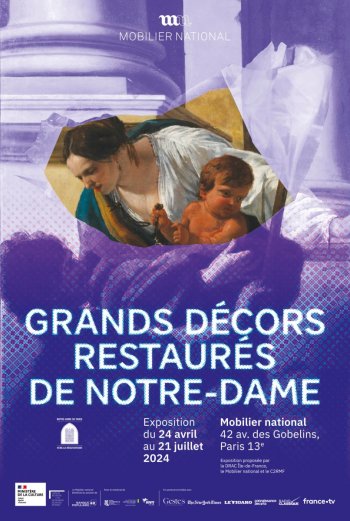 Enfin, en accord avec le diocèse de Paris, sont aussi présentées les maquettes du futur mobilier liturgique actuellement en cours de réalisation. Restauration et création se mêlent ainsi, du XVIIe au XXIe siècle, pour faire de la cathédrale non seulement un fleuron de l’art gothique mais aussi un écrin d’objets d’art et de piété de qualité exceptionnelle.
Enfin, en accord avec le diocèse de Paris, sont aussi présentées les maquettes du futur mobilier liturgique actuellement en cours de réalisation. Restauration et création se mêlent ainsi, du XVIIe au XXIe siècle, pour faire de la cathédrale non seulement un fleuron de l’art gothique mais aussi un écrin d’objets d’art et de piété de qualité exceptionnelle.
Depuis l’incendie de 2019, près de 1 000 artisans travaillent au quotidien à la restauration de la cathédrale. Parmi eux, les restaurateurs de peintures ne sont pas les moins actifs. Ce sont eux qui ont redonné vie et couleur aux grands « mays », ces chefs-d’œuvre de peinture religieuse offerts chaque année au mois de mai, entre 1630 et 1707, par la confrérie des orfèvres de la ville de Paris. Leurs auteurs sont les plus grands peintres français de l’époque : Laurent de La Hyre, Aubin Vouet, Charles Le Brun, Eustache Le Sueur…). Accrochés à l’origine côte à côte dans la nef de la cathédrale, ils formèrent une collection unique en France, dispersée à la Révolution, puis partiellement rassemblée et replacée dans l’édifice.
La restauration de ces grands mays et des autres œuvres peintes, françaises et italiennes, conservées dans l’édifice à la veille de l’incendie et restauration, a été confiée par la DRAC Île-de-France confiée à trois groupements de restaurateurs du patrimoine, avec le soutien du Centre de recherche et de restauration des musées de France. Les treize mays restaurés sont présentés dans un ordre qui évoque leur accrochage originel dans la nef de la cathédrale. Des esquisses et des dessins sont aussi présentés, accompagnés de textes, de multimédia et d’explications qui aident à comprendre la richesse propre de chaque œuvre et le savoir-faire exceptionnel des restaurateurs du patrimoine.
Commissaires
• Caroline Piel, inspectrice des patrimoines, collège Monuments historiques (h)
• Emmanuel Pénicaut, directeur des collections du Mobilier national
assistés de
• Marie-Hélène Didier, conservatrice des Monuments historiques, DRAC Île-de-France
• Oriane Lavit, conservatrice du patrimoine, Centre de recherche et de restauration des musées de France (C2RMF)
Byron 200 Years after His Death
George Gordon Byron (1788–1824) died 200 years ago on Friday (19 April). Writing this week for The Washington Post, Michael Dirda reviews two new books about the poet (noted below), while Benjamin Markovits, in a New York Times essay, grapples with how (and whether) people still read him. A Byron Festival is being held at Trinity College, Cambridge (yesterday and today) while the Keats-Shelley House presents the exhibition, Byron’s Italy: An Anglo-Italian Romance, along with a series of talks and other events throughout the year. Finally (for now), Liverpool UP has discounted some of its Byron books.
The Byron Festival at Trinity
Trinity College Cambridge 19–20 April 2024
 Trinity College Cambridge will host a two-day festival to coincide with the 200th anniversary of Lord Byron’s death on 19 April 1824, in Missolonghi, Greece. Byron was a student at Trinity College and is one of its most celebrated alumni. While enrolled as an undergraduate, Byron published his collection of poetry, Hours of Idleness, and began the satirical poem that would become English Bards and Scotch Reviewers, a scathing provocation of the literary establishment.
Trinity College Cambridge will host a two-day festival to coincide with the 200th anniversary of Lord Byron’s death on 19 April 1824, in Missolonghi, Greece. Byron was a student at Trinity College and is one of its most celebrated alumni. While enrolled as an undergraduate, Byron published his collection of poetry, Hours of Idleness, and began the satirical poem that would become English Bards and Scotch Reviewers, a scathing provocation of the literary establishment.
Described by the College’s Senior Tutor of the time as a “young man of tumultuous passions,” Byron became one of the most controversial, celebrated, and influential poets of his age. When Westminster Abbey declined to accept the magnificent statue of Byron, created after his death by the Danish sculptor Thorvaldsen, Trinity gave it a home in the Wren Library, where the poet still stands—an impressive presence for students, scholars, and visitors.
But what kinds of presence does Byron have now? This question is the focus of an exciting programme of talks, readings, music, and exhibited work, which will address, and mediate, the legacy and status of Byron now, within the contexts of today’s culture and scholarship. The Byron Festival Conference programme includes talks about Byron, by academics and writers including Bernard Beatty, Drummond Bone, Clare Bucknell, Will Bowers, Christine Kenyon Jones, Mathelinda Nabugodi, Seamus Perry, Diego Saglia, Dan Sperrin, Jane Stabler, Fiona Stafford, A.E. Stallings, Andrew Stauffer, Corin Throsby, Clara Tuite, Ross Wilson.
◊ ◊ ◊ ◊ ◊
Fiona Stafford, ed., Byron’s Travels: Poems, Letters, and Journals (New York: Everyman’s Library, 2024), 728 pages, ISBN: 978-1101908426, $35.
 George Gordon, Lord Byron, was one of the leading figures of British Romanticism. The Byronic hero he gave his name to—the charming, dashing, rebellious outsider—remains a powerful literary archetype. Byron was known for his unconventional character and his extravagant and flamboyant lifestyle: he had numerous scandalous love affairs, including with his half-sister Augusta Leigh. Lady Caroline Lamb, one of his lovers, famously described him as “mad, bad and dangerous to know.”
George Gordon, Lord Byron, was one of the leading figures of British Romanticism. The Byronic hero he gave his name to—the charming, dashing, rebellious outsider—remains a powerful literary archetype. Byron was known for his unconventional character and his extravagant and flamboyant lifestyle: he had numerous scandalous love affairs, including with his half-sister Augusta Leigh. Lady Caroline Lamb, one of his lovers, famously described him as “mad, bad and dangerous to know.”
His letters and journals were originally published in two volumes; this new one-volume selection includes poems and provides a vivid overview of his dramatic life arranged to reflect his travels through Scotland, Italy, Spain, Turkey, Albania, Switzerland, and of course Greece, where he died. It contains a new introduction by scholar Fiona Stafford highlighting Byron’s enduring significance and the ways in which he was ahead of his time.
Fiona Stafford is a professor of English literature at Oxford University. The author of many books, including a biography of Jane Austen, she also wrote and presented the highly acclaimed The Meaning of Trees for BBC Radio 3’s The Essay. Her book The Long, Long Life of Trees, published in 2017, was a Sunday Times Nature Book of the Year.
◊ ◊ ◊ ◊ ◊
Andrew Stauffer, Byron: A Life in Ten Letters (Cambridge: Cambridge University Press, 2024), 300 pages, ISBN: 978-1009200165, $30.
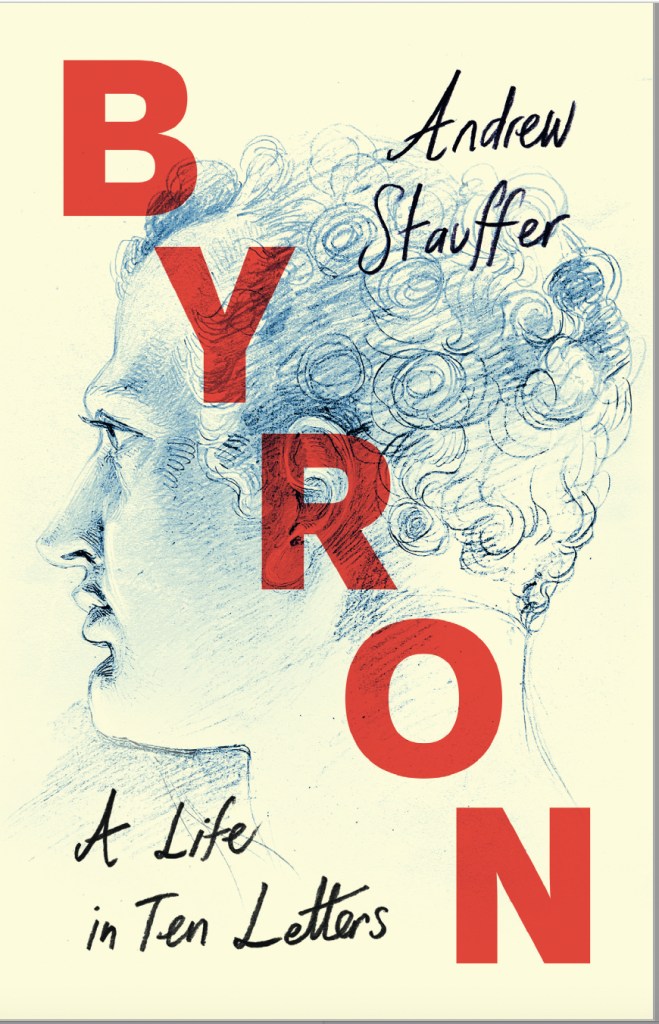
Lord Byron was the most celebrated of all the Romantic poets. Troubled, handsome, sexually fluid, disabled, and transgressive, he wrote his way to international fame—and scandal—before finding a kind of redemption in the Greek Revolution. He also left behind the vast trove of thrilling letters (to friends, relatives, lovers, and more) that form the core of this remarkable biography. Published to coincide with the 200th anniversary of Byron’s death, and adopting a fresh approach, it explores his life and work through some of his best, most resonant correspondence. Each chapter opens with Byron’s own voice—as if we have opened a letter from the poet himself—followed by a vivid account of the emotions and experiences that missive touches. This gripping life traces the meteoric trajectory of a poet whose brilliance shook the world and whose legacy continues to shape art and culture to this day.
Andrew M. Stauffer is a professor in the English Department at the University of Virginia, where he specializes in nineteenth-century literature, especially poetry.
Exhibition | The Tiepolos: Invention and Virtuosity in Venice
Now on view at the Beaux-Arts de Paris:
The Tiepolos: Invention and Virtuosity in Venice
Beaux-Arts de Paris, 22 March — 30 June 2024
Curated by Hélène Gasnault and Giulia Longo
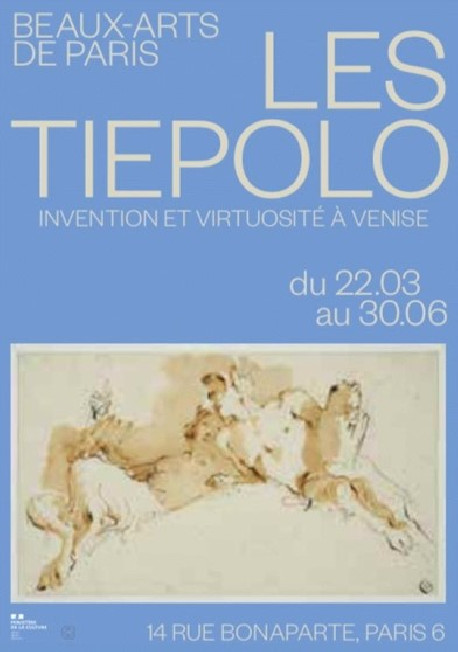 This exceptional exhibition brings together drawings and etchings by Giambattista Tiepolo and his two sons, Giandomenico and Lorenzo Tiepolo, a family of virtuoso artists in 18th-century Venice.
This exceptional exhibition brings together drawings and etchings by Giambattista Tiepolo and his two sons, Giandomenico and Lorenzo Tiepolo, a family of virtuoso artists in 18th-century Venice.
The Beaux-Arts de Paris owns a remarkable collection of ten works by Giambattista Tiepolo (1696–1770), making it the second-largest public collection of the artist’s drawings in France. Above all, this collection is the only one in France to include drawings not only by Giambattista, but also by his two painter sons, Giandomenico (1727–1804) and Lorenzo (1736–1776), as well as another of Tiepolo’s assistants in the 1730s, Giovanni Raggi. This collection alone provides an overview of graphic practices within the family and the studio.
The study of these sheets and prints, combined with works by other artists—sources of inspiration such as Rembrandt, masters such as Piazzetta, and contemporaries such as Canaletto, Guardi, and Novelli—highlights the great modernity of their art. This is particularly evident in their ability to produce variations on the same theme, both in traditional religious and mythological subjects and in figure studies, particularly caricatures, as well as scenes from Venetian life. The exhibition also explores the relationship between the father and his sons, and the work within a family of artists.
The exhibition opens with a series of studies of heads and faces that raise the question of training in the Tiepolo studio. It then moves on to religious paintings and large-scale secular decors produced by the Tiepolos and their contemporaries in Venice, followed by autonomous graphic works conceived outside of any painted project, as pure graphic exercises or pleasures, based on iconographic themes repeated almost obsessively, in multiple variants. It is the exceptional inventiveness of Giambattista and Giandomenico Tiepolo, one of the most fascinating facets of their artistic personalities, that these drawings and prints allow us to rediscover.
Curated by Hélène Gasnault, curator of drawings at Beaux-Arts de Paris, and Giulia Longo, curator of engravings and photos at Beaux-Arts de Paris.
Hélène Gasnault, ed., with additional texts by Catherine Loisel and Giulia Longo, Les Tiepolo: Invention et virtuosité à Venise (Paris: Beaux-Arts de Paris éditions, 2024), 112 pages, ISBN: 978-2840568780, €25.
Exhibition | Disegno Disegni
This exhibition of over 100 Italian drawings closed on Sunday, though there is a catalogue:
Disegno Disegni
Musée Jenish, Vevey, Switzerland, 8 December 2023 — 14 April 2024
Curated by Emmanuelle Neukomm et Pamella Guerdat

Pietro Palmieri, Trompe-l’oeil with eight copied engravings and study drawings stacked on top of each other, 1783, pen, black and brown inks, brown wash, and blue watercolor on paper, 45 × 60 cm (Vevey: Musée Jenish; photo by David Quattrocchi).
Avec Guerchin, Novelli, Piola, Tiepolo ou encore Zuccari, le dessin italien ancien et moderne est au coeur de l’exposition Disegno disegni.
Dans le sillage du legs de René de Cérenville en 1968, qui faisait la part belle à la création graphique de la Péninsule, les fonds italiens du Musée Jenisch Vevey n’ont cessé de s’enrichir au fil des années, constituant aujourd’hui l’un des noyaux essentiels du patrimoine veveysan. Plus de 100 feuilles issues d’une collection particulière déposée au musée depuis 2003 sont mises en lumière pour l’occasion, dans un dialogue fécond avec les propres fonds de l’institution. Les pièces ainsi réunies invitent à voyager à travers les grands centres artistiques d’Italie, de Venise à Rome, en passant par Bologne et Florence. Autant d’écoles à l’origine d’une production dessinée placée sous le signe de la diversité technique et matérielle. Sujets religieux et profanes, pages d’études et dessins autonomes célèbrent la pluralité qui caractérise le médium et ses multiples fonctions, entre la fin du XVe siècle et les premières décennies du XIXe siècle.
Une exposition sous le commissariat de Emmanuelle Neukomm et Pamella Guerdat, conservatrice et conservatrice adjointe Beaux-Arts, assistées de Leïla Thomas, collaboratrice scientifique.
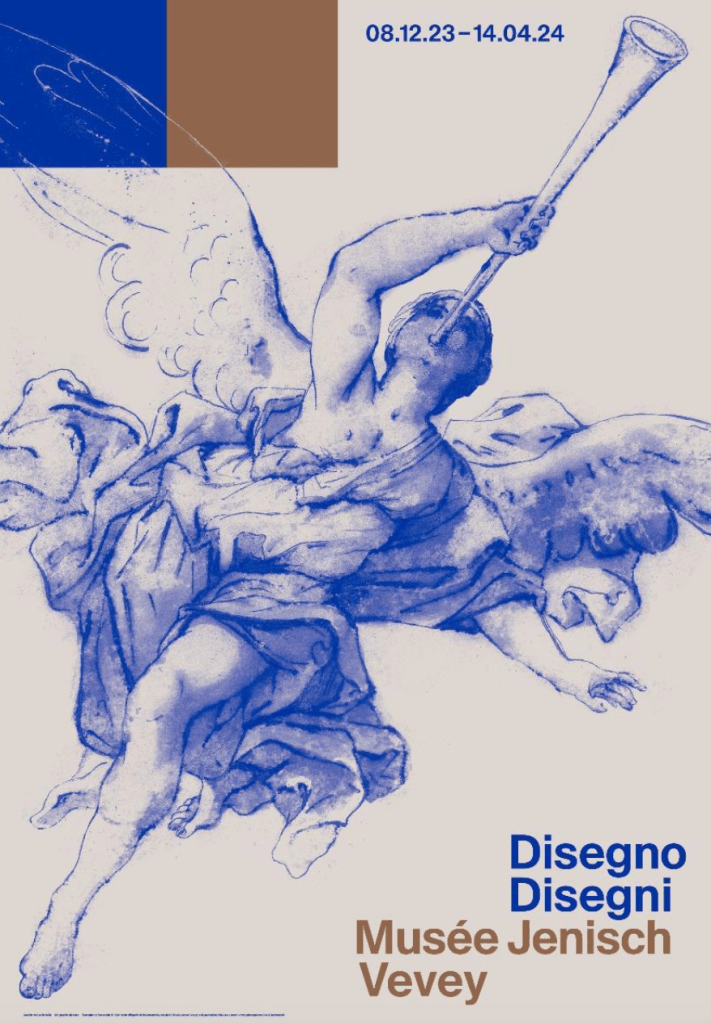
Marcantonio Franceschini, Allegory of Fame, before 1696 (Private Collection).
Pamella Guerdat et Emmanuelle Neukomm, eds., Disegno disegni: Dessins italiens de la Renaissance au XIXe siècle (Milan: Silvana Editoriale, 2024), 340 pages, ISBN: 978-8836654727, €45.
Préface — Nathalie Chaix
Le dédale des provenances — Ètienne Dumont
Connoisseurship et marché de l’art — Frédéric Elsig
Avertissement
Catalogue: Dessins italiens de la Renaissance au XIX siècle
Du dessin, la part maudite — Jérémie Koering
Index
Bibliographie sélective
Remerciements
Impressum

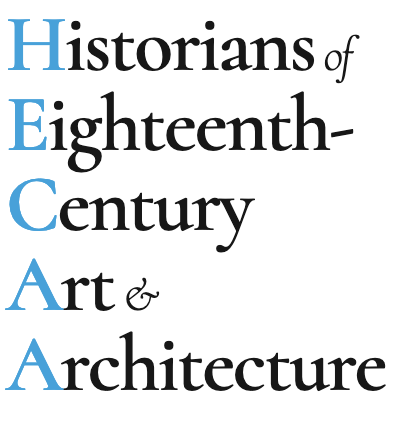

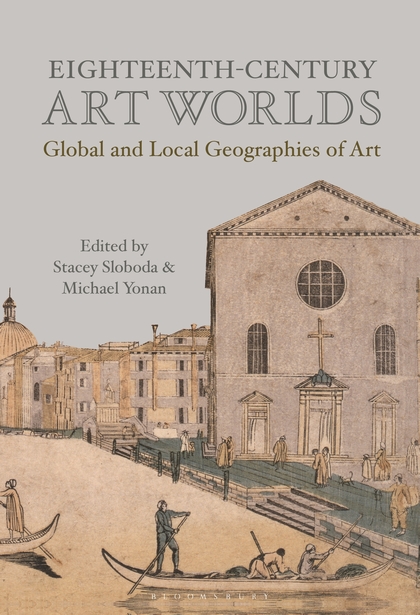

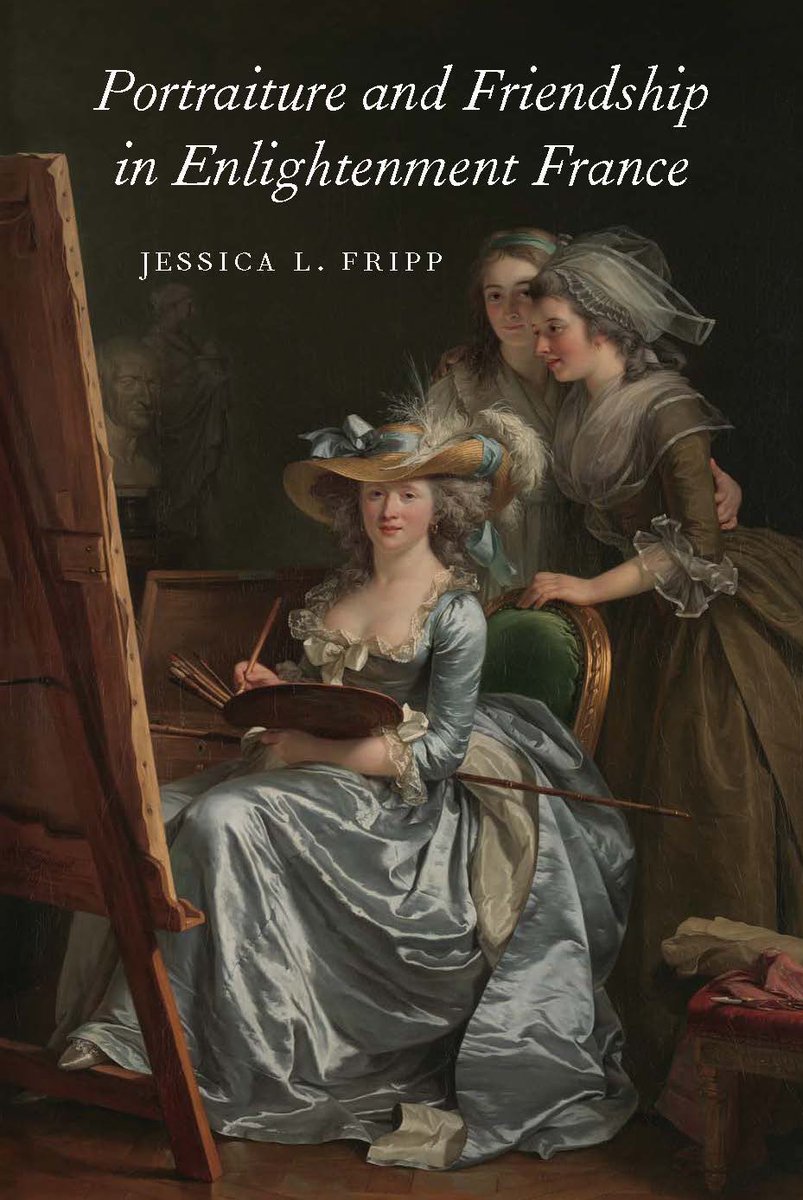















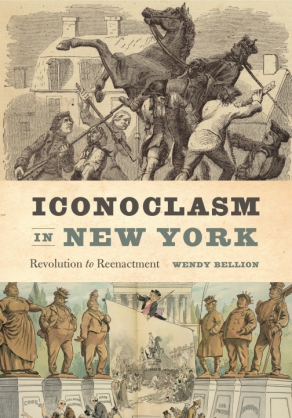



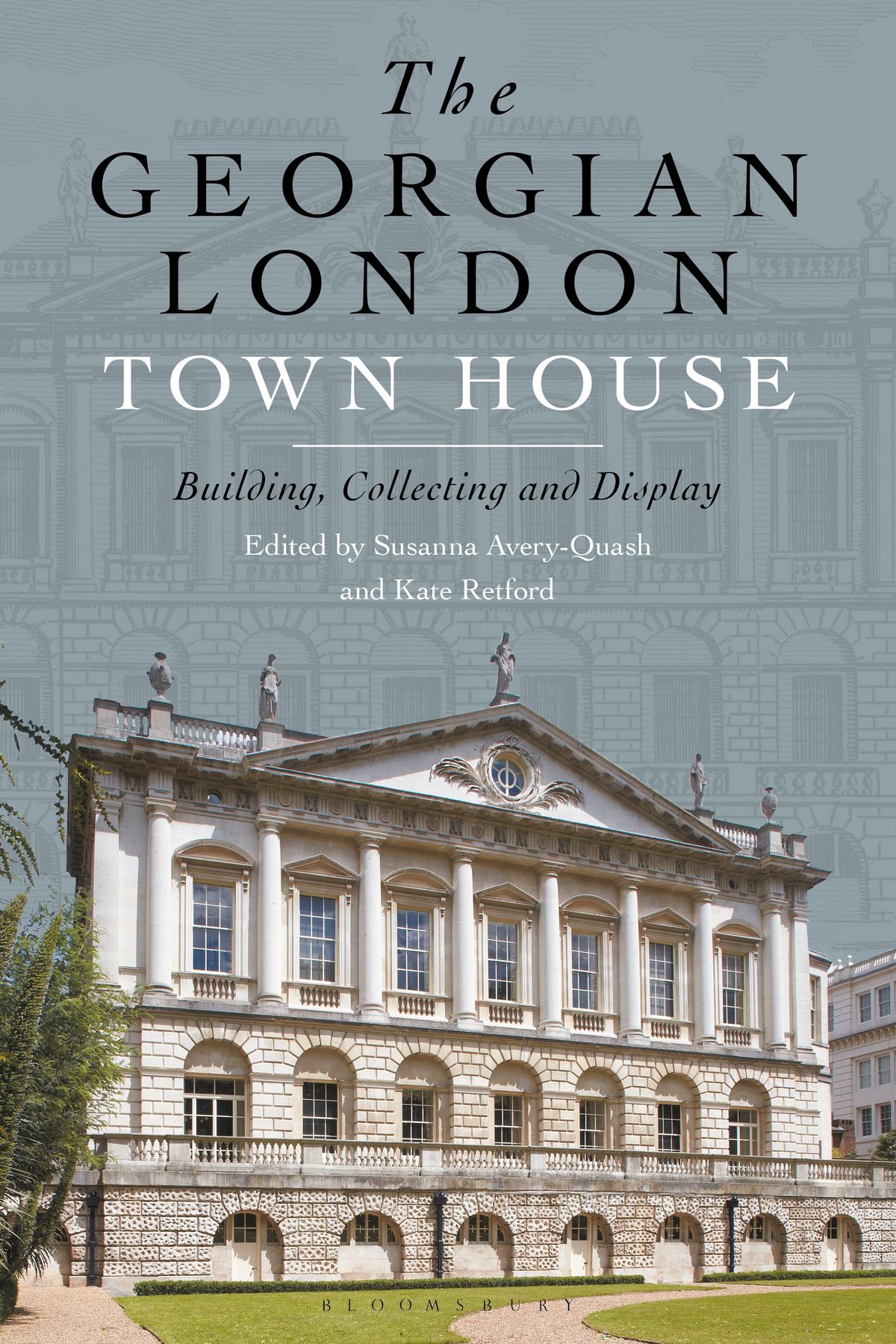


leave a comment